Pas de biographie disponible.
Compositeur Musique additionelle Librettiste Parolier Metteur en scène Chorégraphe Producteur création Producteur version
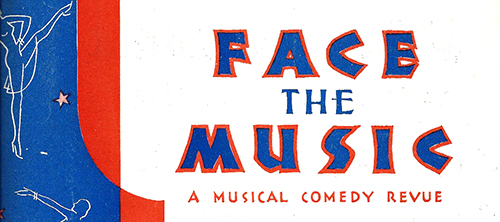
Musical
Musique: Irving Berlin • Paroles: Irving Berlin • Livret: Moss Hart • Production originale: 2 versions mentionnées
Dispo: Résumé Commentaire Liste chansons
The musical was written as a political satire, specifically spoofing political and police corruption that the Seabury Commission was investigating. It also satirized show business, showing the far-fetched economies, such as seeing 4 films with a room and bath for 10¢. The musical did not ignore the Depression but rather found humor in it. There were many titles considered, among them Nickels and Dimes, but Berlin came up with the final title.
Genèse:
Résumé: Producer Hal Reisman desperately seeks backers for his Broadway show. Because of the Great Depression, once-rich investors are "Lunching at the Automat". Kit Baker, a former musical-comedy star and her boyfriend Pat Mason are now out of work and poor ("Let's Have Another Cup of Coffee"). In his search, Reisman meets crooked policemen who need to get rid of their illegal money before they are found out. The corrupt police chief Martin van Buren Meshbesher and his eccentric wife Myrtle become investors in the show, expecting it to be a failure. In the show-within-the-show, Rodney St. Clair sings "My Beautiful Rhinestone Girl". However, when risqué material is added the show is raided and the government tries to close it. The flop becomes a hit because of the publicity.
Création: 17/2/1932 - New Amsterdam Theatre (Broadway) - 165 représ.
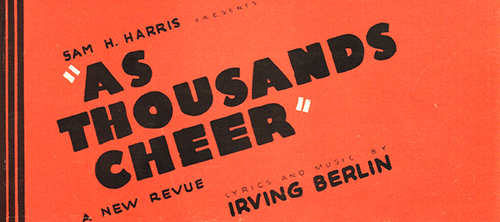
Musical
Musique: Irving Berlin • Paroles: Irving Berlin • Livret: Moss Hart • Production originale: 1 version mentionnée
Dispo: Résumé Génèse Liste chansons
As Thousands Cheer is a revue with a book by Moss Hart and music and lyrics by Irving Berlin, first performed in 1933. The revue contained satirical sketches and witty or poignant musical numbers, several of which became standards, including "Heat Wave", "Easter Parade" and "Harlem on my Mind". The sketches were loosely based on the news and the lives and affairs of the rich and famous, and other people of the day, such as Joan Crawford, John D. Rockefeller, Jr., Noël Coward, Josephine Baker, and Aimee Semple McPherson.
Genèse: The revue was a successor to the creators' Face the Music and was Marilyn Miller's last stage appearance before her death. It was also the first Broadway show to give an African-American star, Ethel Waters, equal billing with whites. Moss Hart said that he and Irving Berlin did not want to write the typical revue with "blackout sketches" and musical numbers, and they had the idea of doing a topical revue "right off the front pages of the newspapers." Berlin deferred his own fees as composer, lyricist, and theater owner, keeping the cost of the show to a "restrained" $96,000.
Résumé: Each of the 21 scenes was preceded by a related newspaper headline, and the sketches poked fun a wide variety of subjects, including the marital woes of Barbara Hutton, Gandhi, and British royalty. The weather report was turned into a song ("Heat Wave"). Other notable scenes include President and Mrs. Hoover leaving the White House, with the President giving his cabinet a Bronx cheer; "Supper Time", an African-American woman's lament for her lynched husband; John D. Rockefeller refusing to accept Radio City Music Hall as a birthday gift; commercials interrupting the singing during a Metropolitan Opera broadcast (P.D.Q. Bach later did this); a hotel staff falling under the influence of Noël Coward; and a fictional Supreme Court decision that says musicals cannot end with reprises, resulting in a new number, "Not For All The Rice In China" (satirizing Barbara Hutton's relationship with Alexis Mdivani), as a finale.
Création: 30/9/1933 - Music Box Theatre (Broadway) - 400 représ.
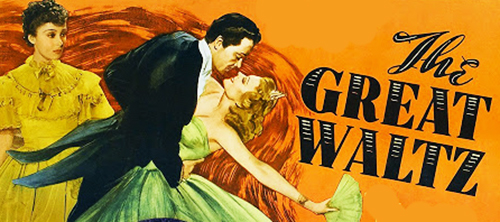
Musical
Musique: Johann Strauss I • Johann Strauss II • Paroles: Desmond Carter • George Forrest • Oscar Hammerstein II • Robert Wright • Livret: A.M. Willner • Moss Hart • Production originale: 4 versions mentionnées
Dispo: Résumé Génèse Liste chansons
Genèse: The Great Waltz debuted on Broadway at the Center Theatre on September 22, 1934 and ran for 289 performances. The production was directed by Hassard Short and presented by Max Gordon, with choreography by Albertina Rasch, settings by Albert Johnson and costumes by Doris Zinkeisen together with Marion Claire, Marie Burke and Guy Robertson. The musical was made into a motion picture by MGM in 1938 with a screenplay and new lyrics by Oscar Hammerstein II. In 1949 impresario Edwin Lester hired Robert Wright and George Forrest to adapt Strauss's German lyrics and music for a production at the Los Angeles Civic Light Opera. This version was used for a London revival that opened at the Drury Lane Theatre on July 9, 1970 and ran for 605 performances. It was also used for a 1972 film remake.
Résumé: Set in Vienna in the spring-time, featuring a conflict between a father and his son, laced with overtures of romance; and though it all a score comprising some of the most loved waltzes ever writeen by the father and son on whose lives the plot is based, and who are truly regarded as the greatest waltz composers of all time. Among a host of tunes, this show contains both "The Radetzky March" and, of course, "The Blue Danube".
Création: 22/9/1934 - Center Theatre (Broadway) - 298 représ.
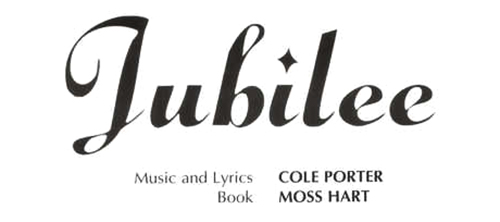
Musical
Musique: Cole Porter • Paroles: Cole Porter • Livret: Moss Hart • Production originale: 1 version mentionnée
Dispo: Résumé Génèse Liste chansons
Jubilee is a musical comedy with a book by Moss Hart and music and lyrics by Cole Porter. It premiered on Broadway in 1935 to rapturous reviews. Inspired by the recent silver jubilee of King George V of Great Britain, the story is of the royal family of a fictional European country. Several of its songs, especially "Begin the Beguine" and "Just One of Those Things", became independently popular and have become part of the American Songbook.
Genèse: The musical opened at the Shubert Theatre in Boston on September 21, 1935 for a three-week pre-Broadway tryout period. The Broadway premiere opened at the Imperial Theatre on October 12, 1935 and closed on May 7, 1936, after 169 performances. Changes in the lead lessened its appeal. Produced by Sam H. Harris and Max Gordon, the production was staged by Hassard Short, who also was the lighting designer, with dialog directed by Monty Woolley, choreographed by Albertina Rasch and Tony De Marco, and with set design by Jo Mielziner. Later productions Despite its popular success, the musical was not signed by a theatrical leasing company for stock or amateur performances after its initial run. Performances between 1936 and 1948 were negotiated by the producers Max Gordon and Sam Harris. In 1948, the St. Louis Municipal Opera used the original orchestrations, but they were lost in transit to the Music Box Theatre. Jubilee became a lost show. It was not produced for 40 years afterward. In 1985, The New Amsterdam Theatre Company hired Larry Moore to reconstruct the show. It was performed in 1986 as part of their series of classic musicals presented in concert at The Town Hall in New York. Alyson Reed played Karen, Carole Shelley was Eva, Patrick Quinn was Eric, and Roderick Cook was the Prime Minister. Rebecca Luker was in the cast. Indiana University Opera staged the musical in 1992.[8] 42nd Street Moon in San Francisco presented concert versions of Jubilee in 1993 and 1997 and a staged production in 2009. In 1998, a concert version was staged at Carnegie Hall, New York City, for the benefit of the Gay Men's Health Crisis. Directed by Herbert Ross, with choreography by Danny Daniels, Lynne Taylor-Corbett and Pierre Dulaine, the cast included Bea Arthur as The Queen, Tyne Daly as Eva Standing, Sandy Duncan as Karen O'Kane, Michael Jeter as The King, Alice Ripley as The Princess, Stephen Spinella as Eric Dare, Bob Paris as Mowgli,[10] and Philip Bosco as Prime Minister. New York's "Musicals Tonight!" theatre troupe presented a staged concert in October 2004. The show has been produced twice by Ian Marshall Fisher's "Lost Musicals In Concert" series in London. The second production, using the BBC Concert Orchestra, was performed in 1999 at Her Majesty's Theatre and broadcast by the BBC. The musical played for five weeks in 2012 at the Tabard Theatre in Chiswick, London.
Résumé: The Royal Family of a fictional European country use the threat posed by an impending revolution as an excuse to abandon the throne and pursue their private dreams. The King meets up with party-giver extraordinaire Eva Standing; the Queen chases after swimmer-turned-actor Charles Rausmiller (a.k.a. Mowgli); the Prince woos songstress Karen O'Kane; and the Princess wins the admiration and attention of playwright/composer/actor Eric Dare. When the revolutionary threat is revealed to be a hoax, the family members are forced to return to power, but they manage to incorporate their newfound friends into their royal lives.
Création: 12/10/1935 - Imperial Theatre (Broadway) - 169 représ.
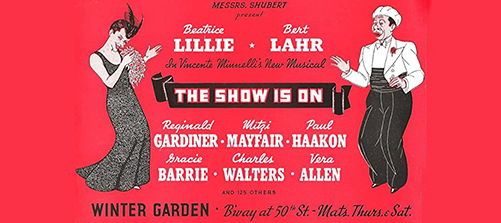
Musical
Musique: George Gershwin • Harold Arlen • Herman Hupfeld • Richard Rodgers • Will Irwin • Paroles: E.Y. Harburg • Herman Hupfeld • Howard Dietz • Ira Gershwin • Lorenz M. Hart • Ted Fetter • Livret: David Freedman • Moss Hart • Production originale: 1 version mentionnée
Dispo:
Genèse:
Résumé:
Création: 25/12/1936 - Winter Garden Theatre (Broadway) - 236 représ.
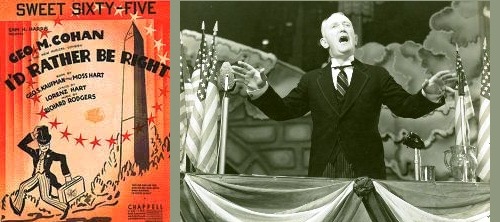
Musical
Musique: Richard Rodgers • Paroles: Lorenz M. Hart • Livret: George S. Kaufman • Moss Hart • Production originale: Sam H. Harris • 1 version mentionnée
Dispo: Résumé Liste chansons
Après le flop en février 1937 de "Fulton of Oak Falls", qui avait marqué après près de 20 ans, la réconciliation de de Cohan et Harris, Cohan a décidé de partir tenter sa chance à Londres… C'est à ce moment que Cohan a reçu un appel de Sam Harris pour rester à New York. Sam avait un rôle pour lui dans sa nouvelle production qu’aucun autre acteur ne pouvait faire. Le rôle était celui de Franklin Delano Roosevelt, et la pièce était "I'd Rather Be Right". Avec le succès de "I’d Rather Be Right" Cohan s’est retrouvé propulsé à nouveau comme roi de Broadway, lefaisant participer à de nombreuses réunions sociales et dîners mondains.
Genèse:
Résumé: Le spectacle se déroule à Central Park à New York, le 4 juillet, le jour de la fête nationale américaine. Peggy et Phil espèrent se marier mais le patron de Phil ne lui donnera pas d’augmentation jusqu’à ce que Roosevelt équilibre le budget. Phil s’endort et rêve qu’ils rencontrent Roosevelt flânant dans le parc. Après que Phil explique le dilemme du couple, Roosevelt promet de l’aider - ce qui n’est qu’une excuse pour quelques blagues se moquant des membres du Cabinet, de la Cour suprême, de la PWA, des conversations au coin du feu, d’Alf Landon, des conférences de presse et de la décision du Président de se présenter pour un troisième mandat.
Création: 2/11/1937 - Neil Simon Theatre (Broadway) - 290 représ.
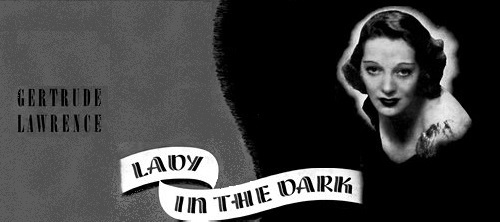
Musical
Musique: Kurt Weill • Paroles: Ira Gershwin • Livret: Moss Hart • Production originale: 2 versions mentionnées
Dispo: Résumé Synopsis Commentaire Génèse Liste chansons
Lady in the Dark a été l’événement musical de la saison 1940-1941, et toutes ses représentations étaient sold-out, y compris les places debout. Tout le monde le savait, cette œuvre était le musical le plus moderne dans laquelle une légende théâtrale jouait le rôle de sa vie. Gertrude Lawrence a joué ce qui était (avec Rose dans le futur Gypsy ()) peut-être le Hamlet des rôles musicaux féminins. Son contrat prévoyait qu'elle avait droit à des vacances l’été. Ainsi, la comédie musicale a joué 162 représentations sold-out, s'est arrêtés les onze semaines de vacances de Gertrude Lawrence, puis a rouvert ses portes à l’automne pour 305 représentations supplémentaires (le total des représentations totalisera 467). Après un US-Tour, en 1943, Lawrence revient au Broadway Theatre pour un 'return engagement' de 83 représentations.
Genèse: Création Le musical a ouvert à Broadway à l'Alvin Theatre (l'actuel Neil Simon Theatre) le 23 janvier 1941 et a fermé le 30 mai 1942 après 467 représentations. Le spectacle produit par Sam H. Harris a été mis en scène par Moss Hart avec une direction musicale de Hassard Short et des chorégraphies d’Albertina Rasch. Les acteurs de la création étaient Gertrude Lawrence, Danny Kaye, Bert Lytell, Victor Mature, Margaret Dale, Davis Cunningham et Macdonald Carey. La performance de Danny Kaye dans le rôle du photographe de mode Russell Paxton, et en particulier sa performance dans la chanson Tschaikowsky (and Other Russians) dans laquelle il énonce les noms de 50 compositeurs russes en 39 secondes, fait de lui une star. Le musical a fait un US-Tour de huit villes et 160 représentations, et a également joué sur la côte ouest, y compris Los Angeles et San Francisco, pour 56 représentations. Le spectacle est ensuite revenu a Broadway, pour ce que l'on appelle un "return engagement" au Broadway Theatre du 27 février au 15 mai 1943 pour 83 représentations. Gertrude Lawrence a joué son rôle de Liza Elliott dans toutes les salles. Autres productions Lady in the Dark a été créée au Royaume-Uni seulement le 9 décembre 1981 au Nottingham Playhouse de Nottingham. A New York City Center Encores! a proposé un concert semi-scénique du en mai 1994 avec Christine Ebersole. Et enfin, le musical a été créé à Londres au Royal National Theatre le 11 mars 1997, présentant 63 représentations jusqu’au 2 août 1997, dans une mise en scène de Francesca Zambello et avec Maria Friedman dans le rôle de Liza. La production a reçu le Evening Standard Award du meilleur musical.
Résumé: Liza Elliott (Gertrude Lawrence), est une éditrice de magazine de mode à succès. Cette dernière se retrouve constamment en proie à l'indécision dans sa vie professionnelle et personnelle. Elle est courtisée par deux hommes, l'éditeur déjà marié Kendall Nesbitt qui tente de divorcer de sa femme pour Liza, et son directeur de la publicité Randy Curtis, et ne peut pas décider qui choisir. Lorsqu'elle décide de recourir à la psychanalyse, elle plonge dans ses rêves et ses souvenirs d'enfance malheureuse. Le musical est constitué ainsi principalement de trois de ses rêves, racontées au psychanalyste. Liza se rend compte qu’elle aime son assistant qui fait preuve de sagesse lorsqu’il termine sa mélodie de rêve, My Ship.
Création: 23/1/1941 - Neil Simon Theatre (Broadway) - représ.